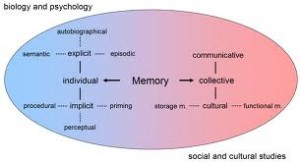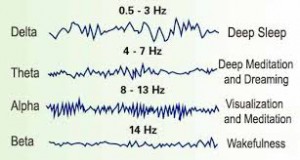Theme of Weekend 4: The Physics of Asana: Understanding fulcrums and leverage, props and support, in your practice and teaching of asana.
Meditation: Resting in Being (Hsin Hsin Ming for clues!)
Mantra Practice: Continue from last month.
Sutras Discussion: 1. Please talk about brahmacharya (from Sutra II-38): Brahmacharya literally means ‘walking in God’. As living beings, we are endowed with a certain amount of energy, strength, and power (virya) to be used in the world. How we use that energy determines the quality of our lives. Are we self-centered? Lost and confused? Chasing shadows? Sexual energy is a major driving force in nature and Patanjali addresses this here, but celibacy is a common but poor translation of brahmacharya. The sutras do have a masculine/transcendence/purusha bias versus the feminine/immanence/prakriti, and if we read between the lines, many commentators (all guys by the way) seem to imply that sex is a hindrance to your spiritual development. It certainly could be, if the 2nd chakra energy is not integrated into the whole being and runs amok in the subconscious. But trying to repress the sexual energy is not a solution either, as can be seen by the Catholic Church scandals of the past decades. Use the energies of life wisely. It takes life times of practice and study to do this, so be patient and persistent. But liberation does not require the suppression of the creative energies, only its integration.
 2. The gunas; In sutra II-18 and II-19, Patanjali discusses the gunas, the three qualities of prakriti. In II-19, he connects the gunas to the 24 components of the Samkhya model of reality dealing with prakriti, dividing these 24 into 4 categories, ranging from most tangible to most subtle. There are 16 most tangible or gross body components and they include the 5 organs of action, 5 organs of perception, and the 5 gross elements. Those are obvious. Manas or ‘lower mind’ is the 16th, as it is the least subtle of the mental components. Next come the 6 subtle components; the 5 energies that correspond with he organs of perception: sight, sound, touch, taste and smell; and ahamkara, the egoic mind, more subtle than manas. Mahat or buddhi is in a category by itself, as it is more subtle than the previous components, but still distinctive as a separate entity. The final category is prakriti itself, before it manifests as any particular form. These models or maps are fun, but don’t get too distracted by them. Live…Fully… that is all you need to awaken.
2. The gunas; In sutra II-18 and II-19, Patanjali discusses the gunas, the three qualities of prakriti. In II-19, he connects the gunas to the 24 components of the Samkhya model of reality dealing with prakriti, dividing these 24 into 4 categories, ranging from most tangible to most subtle. There are 16 most tangible or gross body components and they include the 5 organs of action, 5 organs of perception, and the 5 gross elements. Those are obvious. Manas or ‘lower mind’ is the 16th, as it is the least subtle of the mental components. Next come the 6 subtle components; the 5 energies that correspond with he organs of perception: sight, sound, touch, taste and smell; and ahamkara, the egoic mind, more subtle than manas. Mahat or buddhi is in a category by itself, as it is more subtle than the previous components, but still distinctive as a separate entity. The final category is prakriti itself, before it manifests as any particular form. These models or maps are fun, but don’t get too distracted by them. Live…Fully… that is all you need to awaken.
3. Vibhuti Pada? Forget the third chapter, after samyama, as it is too technical and not relevant to awakening. Keep your study practical. Can you immediately apply this sutra to your moment to moment experience? If so, go for it. If not, find something else. There is plenty to work with, but try not to get lost in theoretical speculation. It is a waste of time if your goal is awakening. If your goal is to be a Yoga Sutras scholar, that is another story.
Here are some practical sutras to work with: I-12 to I-16, the practices of abhyasa and vairagyam.
Abhyasa: choosing to put your energy into actions/thoughts/practices that stabilize mindfulness, emotional balance (samatvam), clarity, joy, delight; or any mind state that comes from a deep sense of inner peace and wisdom; and doing this lovingly, persistently, over many years and lifetimes. Make this practice moment to moment!
Vairagyam: Choosing to withdraw energy from habits, actions, thoughts, beliefs, mind states that perpetuate unnecessary pain, negative emotions and suffering. This is also known as ‘maturing’ or growing up into spiritual adulthood. Make this practice moment to moment! (Sutra I-16 has some anti-feminine bias, so be careful with that one. It is crucial to differentiate Purusha from Prakriti, the changeless eternal from the transient world of forms. Differentiating leads to deeper levels of integration. However, ‘indifference to nature’, is not awakening. On the contrary, it is a place of ‘stuckness’.)
Asana Practice:
As we continue our inquiry into the energy and information flow passing through our body/minds, we come to the practical side of asana practice. There are many ways we use yoga postures to enhance perception and sensitivity to energy, and using props to highlight keys places of leverage and balance is one of B.K. S. Iyengar’s greatest gifts to the modern yogi. The Iyengar system has spawned an amazing number of ways to use props to improve leverage, awaken a deeper sense of space in the poses, and open and integrate the chakra energies. We will explore a few possibilities.
Because of the long bones of the limbs and the action of the joints, the human body is an amazing place to explore leverage and the role of fulcrums in creating a sense of balance 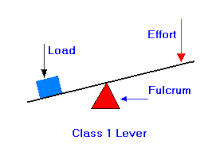 and ease, of sthira and sukham. This class of leverage is the see-saw action we use in opening
and ease, of sthira and sukham. This class of leverage is the see-saw action we use in opening  the hip joints. When we grow a tail, and use the inner back heel as a continuation of tail energy, the center of the front leg hip socket is the fulcrum around which the pelvis can rotate
the hip joints. When we grow a tail, and use the inner back heel as a continuation of tail energy, the center of the front leg hip socket is the fulcrum around which the pelvis can rotate  freely, and also a center around which the body can find the stillness of perfect balance. The leverage of the back leg/tail counter-balancing the torso is most clearly seen in half moon pose, especially when you compare Iyengar to the class 1 level picture. The same principle applies to trikonasana and the other standing poses.
freely, and also a center around which the body can find the stillness of perfect balance. The leverage of the back leg/tail counter-balancing the torso is most clearly seen in half moon pose, especially when you compare Iyengar to the class 1 level picture. The same principle applies to trikonasana and the other standing poses.
The use of belts allow us to further enhance the connection of the back leg/tail and front hip joint in the main hip opening postures such as parvsvottanasana, here demonstrated by Iyengar teacher Roni Brissette,  and supta padangusthasana. Note the second belt in supta padangusthasana from the upper hip to the lower foot. A more precise placement of the belt would have it around the metatarsal bones, especially the big toe of that lower leg. That gives you the ability to adjust inner and outer rotations.
and supta padangusthasana. Note the second belt in supta padangusthasana from the upper hip to the lower foot. A more precise placement of the belt would have it around the metatarsal bones, especially the big toe of that lower leg. That gives you the ability to adjust inner and outer rotations. Most beginners use only the upper leg belt and never quite get into the hip joint. The same action can be taken into ardha chandrasana and revolved ardha chandrasana.
Most beginners use only the upper leg belt and never quite get into the hip joint. The same action can be taken into ardha chandrasana and revolved ardha chandrasana.
Another old favorite, done with belts or wall ropes is the hanging dog pose. 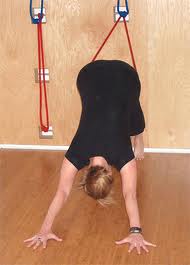 Here the rope loop acts as an accessory tail, teaching the muladhara to trifurcate, giving a strong traction to the hip sockets and tops of the thigh bones. When the hips are open,
Here the rope loop acts as an accessory tail, teaching the muladhara to trifurcate, giving a strong traction to the hip sockets and tops of the thigh bones. When the hips are open,  the leverage releases the spinal column. Speaking of belts and tails, here is a great photo from Lauren Cahn in the upside down downward dog, or urdhva dhanurasana. Notice the action and direction of the pull of the belt. The tail lengthens out dynamically. The tendency is to confuse the tail and the hips and overly contract the muladhara. The use of blocks takes some of the effort from the shoulders.
the leverage releases the spinal column. Speaking of belts and tails, here is a great photo from Lauren Cahn in the upside down downward dog, or urdhva dhanurasana. Notice the action and direction of the pull of the belt. The tail lengthens out dynamically. The tendency is to confuse the tail and the hips and overly contract the muladhara. The use of blocks takes some of the effort from the shoulders.
Once the hips and tail are awake and the energy is flowing freely, (1st chakra) we can look to opening the sacroilliac joints, a key, but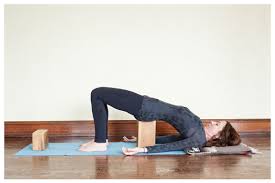 challenging action. Here we switch to a wooden block, or brick as they say in Pune. Iyengar instructor Holly Walck is demonstrating the use of a block in bridge pose to open the core. The release the sacrum the fulcrum shifts from the hip joints to the sacro-illiacs. The feet stay engaged, the pelvis is anchored to the block, and the tail can adjust up or down to find the happy spot for the sacrum. In this photo, the student needs to release the throat as the fifth chakra is compressing. More height under the shoulders and a slight rotation of the skull will align 5th and sixth chakras with the sacral area or the 2nd chakra.
challenging action. Here we switch to a wooden block, or brick as they say in Pune. Iyengar instructor Holly Walck is demonstrating the use of a block in bridge pose to open the core. The release the sacrum the fulcrum shifts from the hip joints to the sacro-illiacs. The feet stay engaged, the pelvis is anchored to the block, and the tail can adjust up or down to find the happy spot for the sacrum. In this photo, the student needs to release the throat as the fifth chakra is compressing. More height under the shoulders and a slight rotation of the skull will align 5th and sixth chakras with the sacral area or the 2nd chakra. 
For those looking for a deeper experience, check this out. Here Iyengar is using a stool with blankets to open his sacral-lumbar region and the heart, the wall to activate his feel and muladhara, and another stool to anchor his hands (notice the length through his wrists, elbows and armpits.) He has been exploring these deep supported backbends for years, as this is his (and the human’s) edge.
 Leveraging the different vertebrae of the spinal column can also be done with chairs. These poses are quite intense and care must be taken not to hang out or hold on, but to use the chair to direct perception. Iyengar teacher, Kisa Davison, at left in viparita dandasana, is demonstrating the classical Iyengar chair backbend. Her head is supported, legs dynamic, but there is some compression at T-12 as seen by the sharp angle between the bottom of the ribs and the abdomen. The seat of the chair would be better located either lower or higher on the spine, as T-12 is very vulnerable to this hinging. If you work organically, rotating the liver would also help ease the transition between 3rd and 4th chakras.
Leveraging the different vertebrae of the spinal column can also be done with chairs. These poses are quite intense and care must be taken not to hang out or hold on, but to use the chair to direct perception. Iyengar teacher, Kisa Davison, at left in viparita dandasana, is demonstrating the classical Iyengar chair backbend. Her head is supported, legs dynamic, but there is some compression at T-12 as seen by the sharp angle between the bottom of the ribs and the abdomen. The seat of the chair would be better located either lower or higher on the spine, as T-12 is very vulnerable to this hinging. If you work organically, rotating the liver would also help ease the transition between 3rd and 4th chakras.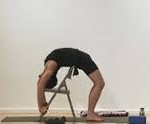
Here the back of the chair is used by Noah Maze to open the 3rd chakra region. Note the hands and compare the length of the armpits to those of Mr. Iyengar, just to get used to seeing energy patterns.  Priscilla Polonia is using the chair and a bolster in supported camel pose (ustrasana). Feet stay active, pressing down, tail energy keeps lengthening, and the head is supported by the back of the chair. Adjust the placement and size of the bolster to fit the needs of your body.
Priscilla Polonia is using the chair and a bolster in supported camel pose (ustrasana). Feet stay active, pressing down, tail energy keeps lengthening, and the head is supported by the back of the chair. Adjust the placement and size of the bolster to fit the needs of your body.
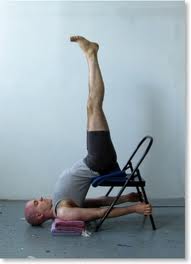 Finally, Iyengar’s chair sarvangasana, here demonstrated by Iyengar teacher Witold Fitz-Simon, uses blankets (or a bolster) for the shoulders, padding for the sacrum, and the arms extend through to the back legs. The arms can also be outside if the shoulders are lacking in flexibility. A bolster can also be placed on the seat of the chair and the legs can then extend back into its support.
Finally, Iyengar’s chair sarvangasana, here demonstrated by Iyengar teacher Witold Fitz-Simon, uses blankets (or a bolster) for the shoulders, padding for the sacrum, and the arms extend through to the back legs. The arms can also be outside if the shoulders are lacking in flexibility. A bolster can also be placed on the seat of the chair and the legs can then extend back into its support. 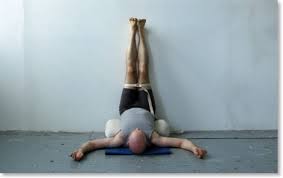
A simpler pose for beginners, and everybody, is viparita karani, one of the main restorative postures. Witold has the bolster near the wall so the legs are supported and a belt contains the leg energy.
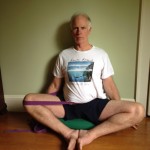 Belts can also be used in baddha konasana and supta baddha konasana. In baddha konasana, a belt (or two, if you want to do both legs) is wrapped around the pelvis and one knee. Make sure that when you tighten the belt, the inner knee skin is pulled from the inside out and around to the outside of the knee. Use the femur bone to push straight out into the belt. Do not try to pull the thigh back toward the wall or down to the floor. Use the belt as a vector and feel its effect of the opposite sacro-illiac joint. Do second side, flipping the belt completely over. Satnd up and walk around to feel the effects.
Belts can also be used in baddha konasana and supta baddha konasana. In baddha konasana, a belt (or two, if you want to do both legs) is wrapped around the pelvis and one knee. Make sure that when you tighten the belt, the inner knee skin is pulled from the inside out and around to the outside of the knee. Use the femur bone to push straight out into the belt. Do not try to pull the thigh back toward the wall or down to the floor. Use the belt as a vector and feel its effect of the opposite sacro-illiac joint. Do second side, flipping the belt completely over. Satnd up and walk around to feel the effects. 
In supta baddha konasana, the belt wraps around the pelvis and comes under the feet at the ankles. Loosen or tighten to find a happy place. Slightly extend through the feet to simulate an extending tail so the muladhara energy lengthens the groins. Use blocks, blankets or bolsters to support the thighs so there is no sense of pulling in the inner thigh (gracilis muscle) which can lock up quite easily. A bolster or blanket can also be used to support the torso and head.






